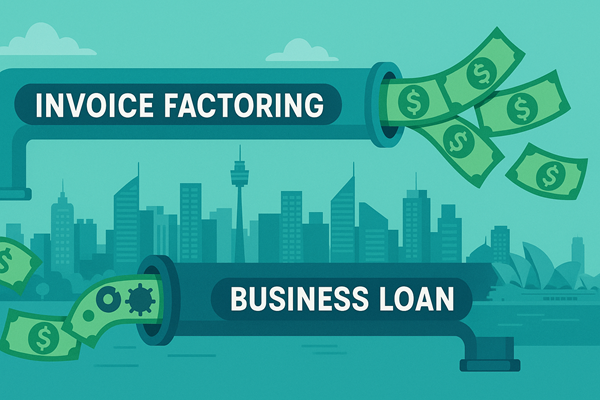Compare invoice factoring and loans for cash flow finance in Australia. Discover the best fit for your small business growth and working capital needs.
Key takeaways
Short on time? Here’s what you need to know:
- Invoice factoring unlocks up to 95% of your unpaid invoices within 24–48 hours, with no debt or repayments—ideal for fast-moving businesses.
- Business loans offer lump sum funding but come with fixed repayments, interest, and potential collateral or personal guarantees.
- Over 40% of Australian SMEs face regular cash flow issues, with late payments averaging 6.4 days overdue.
- 38% of startups fail due to cash flow constraints, making flexible funding a key survival factor.
- Invoice factoring is growing fast in Australia, with the industry valued at $6.5 billion in 2023.
- Choosing between factoring and loans depends on your industry, growth stage, cash cycle, and risk appetite.
Introduction: Cash flow is king, but how should you fund it?
Cash flow is the heartbeat of every successful Australian business. Whether you're a startup chasing growth or a scale-up managing larger contracts, accessing capital at the right time is crucial. But with interest rates still biting in 2025 and payment delays common across most industries, the big question remains:
Should you use invoice factoring or take out a business loan to improve cash flow?
Both funding methods offer pros and cons, and the best option depends on your business model, cash flow cycles, and growth plans. In this article, we break down the differences, look at the numbers, and help you decide which one is right for your current needs.
Understanding invoice factoring
Invoice factoring lets you convert unpaid invoices into fast cash—without waiting 30, 60, or even 90 days for payment.
How it works:
- You issue an invoice to your customer.
- A factoring provider advances you 80% to 95% of the invoice value upfront—usually within 24–48 hours.
- Once the customer pays, you receive the remaining amount minus a small fee (typically 1–5%).
Key benefits:
- Fast access to cash without taking on debt.
- No repayments or interest charges—funding is tied to your actual invoices.
- Scales with your sales—the more you invoice, the more cash you can unlock.
- Ideal for B2B businesses with regular invoicing and good customer credit.
Who it suits:
- Startups, scale-ups, and growing SMEs with reliable customers but slow payment terms.
- Industries like construction, logistics, wholesale, tech, and professional services.
Understanding business loans
Business loans are lump sum amounts borrowed from banks or alternative lenders. You repay the amount (plus interest) over a set term—usually monthly.
Types of business loans in Australia:
- Secured loans: Backed by assets like property or equipment.
- Unsecured loans: No collateral needed but higher interest rates.
- Short-term loans: Designed for fast funding over 3–12 months.
- Long-term loans: Structured over several years for major investments.
Key benefits:
- Predictable repayments help with budgeting.
- Larger loan amounts may be available for asset purchases or expansion.
- Can be used for a wide variety of purposes beyond working capital.
Who it suits:
- Established businesses with stable cash flow, good credit history, and long-term plans.
- Ideal for equipment purchases, renovations, or expansion into new markets.
How they compare: Invoice factoring vs business loans
Choosing between these two options often comes down to your business’s financial needs and risk tolerance. Here’s how they compare across key areas:
Speed of funding
- Invoice factoring: 24–48 hours (based on invoice approval).
- Business loan: 1–4 weeks (depends on lender and documentation).
Impact on debt
- Invoice factoring: No new debt added to your balance sheet.
- Business loan: Increases liabilities and requires regular repayments.
Cost
- Invoice factoring: 1–5% of invoice value, only when you use it.
- Business loan: Interest rates typically between 8–16% p.a. plus possible fees.
Repayment risk
- Invoice factoring: No repayments—funding is tied to customer payments.
- Business loan: Fixed repayments regardless of business performance.
Security required
- Invoice factoring: Usually unsecured; based on customer creditworthiness.
- Business loan: May require collateral or personal guarantees.
Usage flexibility
- Invoice factoring: Best for short-term cash flow tied to receivables.
- Business loan: Better for long-term investments or major one-off expenses.
Current market trends in Australia
Rising interest rates increase loan costs
With the RBA cash rate holding at 4.35% as of early 2025, loan interest rates remain high. This has pushed many Australian businesses to seek non-debt-based alternatives like invoice factoring to maintain working capital.
Late payments are still common
According to Xero Small Business Insights, the average invoice in Australia is paid 6.4 days late, impacting over 61% of SMEs. Invoice factoring bypasses this delay entirely by front-loading your cash.
Fintech innovation fuels factoring growth
New digital-first providers like Waddle, FundTap, and Earlypay have made invoice factoring easier, faster, and more transparent, increasing adoption among younger, tech-savvy founders.
When to choose invoice factoring
You might lean towards invoice factoring if:
- You’re waiting on large invoices from reputable B2B clients.
- You need working capital fast to fund payroll, marketing, or fulfil orders.
- You want to avoid debt or can’t qualify for traditional financing.
- Your customers have strong credit ratings but pay slowly.
- You run a seasonal business with fluctuating cash flow.
Ideal for:
- SaaS companies selling to enterprises
- Freight and logistics providers
- Construction subcontractors
- Creative and professional service firms
When to choose a business loan
Business loans are a solid choice when you need larger sums of capital for planned, long-term investments. Unlike invoice factoring, which supports short-term cash flow gaps, a business loan gives you a lump sum upfront that’s repaid over time—making it ideal for more strategic spending.
Consider a business loan when:
- You’re investing in growth assets – such as equipment, vehicles, or property upgrades that will generate returns over time.
- You have a strong cash flow history – and can comfortably meet regular repayments without straining your operations.
- You want predictable financing – with fixed interest rates and repayment schedules that make budgeting easier.
- You’re consolidating debt – and want to streamline repayments under better terms.
- You don’t issue many invoices – or your business doesn’t have a steady stream of receivables suitable for factoring.
In Australia, small business loans of up to $500,000 are widely available through banks and non-bank lenders, often with government-backed options like the SME Recovery Loan Scheme. Just be mindful of fees, security requirements, and your repayment capacity—especially in a rising rate environment.
If your goal is long-term growth over short-term liquidity, a business loan could be the right fit.
Conclusion: Choose the funding that fits your cash flow needs
In today’s uncertain market, managing cash flow smartly is key to staying agile and growing strong. Invoice factoring offers fast, flexible funding without debt—ideal if you’re waiting on payments and need working capital now. Business loans provide structured, long-term finance suited to major investments, but come with repayments and risk.
The best option depends on your cash cycle, customer base, and growth goals. Many businesses use both to stay balanced. Choose the solution that supports your cash flow—so you can grow on your terms.


